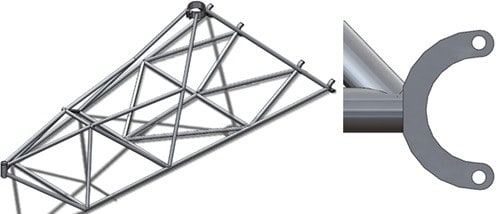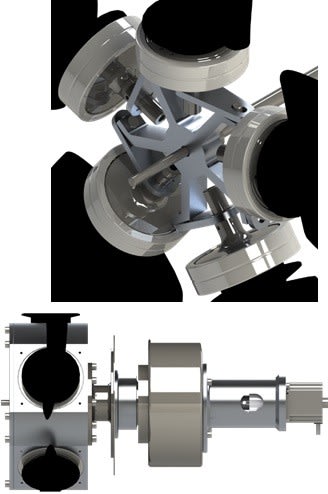WPV Construction - Sussex Power Storm
Follow articleHow do you feel about this article? Help us to provide better content for you.
Thank you! Your feedback has been received.
There was a problem submitting your feedback, please try again later.
What do you think of this article?
Taking it Apart is Easy!
When the current team took over the reins on this project, we were made aware of several sources of failure on the vehicle, recounted by previous team members and the project supervisor. Fortunately, the vehicle was left mostly in one piece, and as such the team was able to consolidate the accounts of the vehicle’s robustness that we had heard and also explore the inner workings for ourselves. Points of interest for repair and team projects included strengthening the chassis at the front wheel to avoid fracture of the welds, recreating the intended worm-drive steering system while avoiding shaft failure, the repair or redesign of the rear axle for better grasp of the rear wheels and avoid deformation, and re-examine the positions of driver controls such as pedals, steering and gear-lever for better ergonomics.
We used the opportunity of dismantling the existing vehicle to not only familiarise ourselves with how it goes together but also to clean up and repair any faulty components. Our intention was to have the vehicle complete and operational as is so we could take it out to the testing ground and get it running ourselves. At this time, projects for the future WPV were being allocated to the team members, and an appropriate understanding of how each member’s projects interface together, and how they will in the future, is vital to the team’s success.
The Team’s Work Scope
Our investigative process on last year’s vehicle led to the dividing of projects for the team in the following manner:
- In-depth empirical analysis of the existing turbine for the benefit of the Variable Pitch Turbine.
- Mechanical design of the Variable Pitch Turbine.
- Design of the control system for the Variable Pitch Turbine.
- Mechanical design of the Splitter Diffuser.
- Computational Fluid analysis of the Splitter Diffuser.
- Redesign of the chassis.
- Redesign of the steering system.
- Redesign of the rear axle and braking system.
- Design of a new cockpit and driver interfaces.
- Redesign of the body and streamlining shrouds for the pylon.
Most of these projects are not simply intended to fix broken items, but to vastly improve the performance of the vehicle and help play to our strengths. Last year’s WPV came 1st in the drag race, and we hope to maintain that lead. We also wish to increase our overall position up from 5th place by improving our performance in the other events. Finally, it is hoped that a couple of these new components, such as the Variable Pitch Turbine and the Splitter Diffuser, would qualify for the special innovation prize, as they are seldom employed by other teams. The Splitter Diffuser, especially, is otherwise unique to this vehicle competition-wide.
Let’s Get Started
The first item to be manufactured in its entirety was the chassis. This was a space-frame design produced from uniform extruded aluminium tubing, cut and welded to size. The design of the chassis was intended to increase the support for the rear axle, and provide enough room to adequately accommodate the new driver interface mechanisms without constraining the driver in a tight uncomfortable space.
The next long-term construction project was the variable-pitch turbine hub. This was uncharted territory for the team and so the mechanisms were co-designed with one of the university’s technicians. The purpose of blade pitch altering is to select any desired blade stagger angle for maximum power extraction from the wind, because altering the change in velocity across the blades to a maximum angle of incidence prior to stall, and thus the maximum torque on the rotor, ensures maximum efficiency. The Variable Pitch Mechanism consists of an aluminium hub with a 5-blade rotor, which are revolved through the back-and-forth movement by virtue of a ‘spider’ arm assembly located on the shaft, offering a pitch change of 35° (±17.5 from midpoint).
Other new items to be manufactured and assembled on the chassis include the rear axle and wheel hubs. The new axle is one piece through the centre differential and coupled to the newer large-radius driving wheels using Hooke joints with keyways to absorb the expected torsional and radial loads, and at the end of the shafts are connecting hubs with pins to slot into the wheel hubs. The steering system took its place at the front of the vehicle with a brand-new drive shaft made of a stronger material and better supported to avoid the previous instance of the shaft shearing at the inner key on the worm-drive gearbox.
Work on the driver interface centres around producing a new combined gearshift and clutch actuator unit, ensuring that at least one hand is always free to operate the steering. It also incorporates a cockpit control system consisting of a driver display with information such as turbine rpm, current gear and racing style LED shift lights to indicate the current turbine rpm and the optimal time to shift gear, all driven using Arduino programmable electrical control systems.
Components:
- Arduino Mega (Micro-Controller) - Red box
- Driver Display - Blue box
- Combined Gear Shifter and clutch actuator - Green box
- Rear axle speed sensor - Grey box
- Data logger - Black box
- Display contrast control - Purple box
- Turbine speed mock - Orange oval
- 12V power pack - Yellow oval
- Mock rear axle (DC Motor) - Purple oval
Whilst other ancillary items such as the diffuser splitter and any replacement core components were manufactured, attention was turned to refitting the bodywork. An external company carried out repairing the shattered carbon fibre shroud, which involved filling and smoothing out any holes or fractures in the carbon fibre sheet. The intention is that the two halves of the bodywork will be more professionally conjoined together using a rubber seal.
The rest of the construction work for the WPV involved refurbishing and refitting pre-existing components back on the vehicle and ensuring they perform as intended. A generous £2000 sponsorship package from RS-Components DesignSpark was instrumental in the team's swift action.









